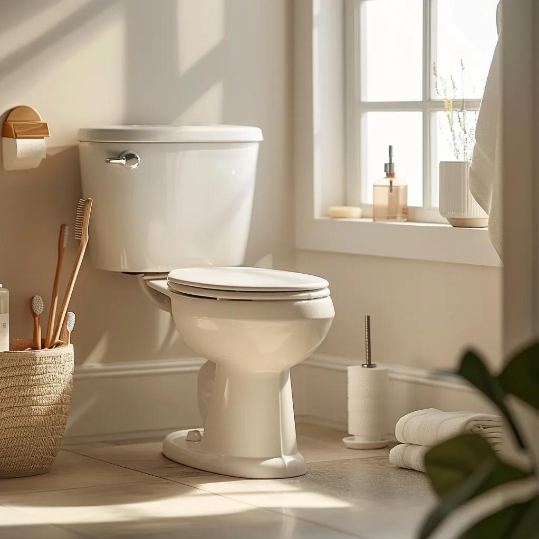
Best Tips to Prevent Blocked Toilet: Expert Advice from Mitchel Plumbing and Gas
When it comes to maintaining a smoothly functioning bathroom, preventing a blocked toilet is a priority for every homeowner. According to the experts at Mitchel Plumbing and Gas, taking a proactive approach to toilet care can significantly reduce the likelihood of clogs and backups. Their recommendations center around simple yet effective practices that can easily be integrated into daily routines. From understanding what materials can and cannot be flushed, to the importance of regular maintenance, the tips provided by Mitchel Plumbing and Gas equip homeowners with the knowledge to safeguard their plumbing systems.
One of the foremost pieces of advice offered by these plumbing professionals is to always be mindful of what goes down the toilet. Items like wipes, dental floss, and personal hygiene products, despite being labeled as “flushable,” can wreak havoc on plumbing systems. Instead, they stress sticking to toilet paper and human waste only. Additionally, incorporating a preventive cleaning routine such as using enzymatic cleaners periodically can help keep the pipes clear of debris that may lead to blockages. By embracing these expert insights from Mitchel Plumbing and Gas, homeowners can not only prevent blocked toilets but also enhance the longevity and efficiency of their plumbing infrastructure.
A single clogged toilet can turn your morning routine into an urgent plumbing crisis, but with the right blocked toilet prevention strategies, you can maintain smooth drainage and avoid emergency repairs. In this guide, Mitchel Plumbing and Gas combines professional insights with practical homeowner actions to cover:
- The most common causes of toilet blockages and how they form
- Daily habits that protect your drain system from clogs
- Routine maintenance checks and our preventative maintenance plans
- Signs that require professional intervention and our tailored solutions
- Upgrades, safe DIY methods and product recommendations for long-term prevention
Our expertise in drain cleaning, hydro-jetting and advanced diagnostics informs every tip, ensuring you prevent toilet clogs before they start.
What Are the Most Common Causes of Toilet Blockages?

Toilet blockages occur when materials or debris accumulate in the bowl, trap or drain line, obstructing water flow and risking overflow. Identifying these root causes empowers homeowners to implement targeted prevention and maintain uninterrupted flushing performance. For example, mineral deposits from hard water can adhere to pipe walls, gradually narrowing the passage and triggering slow drainage.
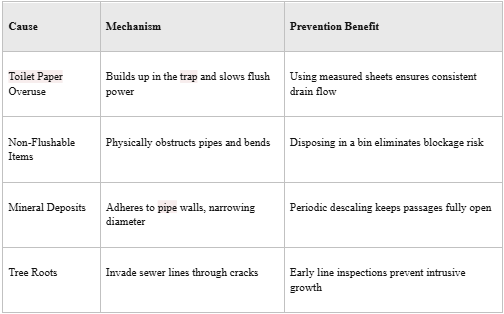
Causes of Toilet Blockages
Toilet blockages are often caused by a combination of factors, including the overuse of toilet paper, the flushing of non-flushable items, and mineral deposits from hard water. These factors can lead to obstructions in the toilet trap and drain lines, hindering water flow and potentially causing overflows. Recognising these causes lays the foundation for daily habits that support clog-free performance.
How Does Excessive Toilet Paper Use Lead to Clogs?
Excessive toilet paper use overwhelms the trap by forming dense mats that resist water flow, causing partial or complete blockages. When homeowners fold and layer too many sheets, the paper fails to break down fully and accumulates at the trap’s bend. Reducing the quantity per flush and choosing quick-dissolving, septic-safe rolls helps maintain optimal flushing strength and prevents matting in the narrow trap section.
Which Non-Flushable Items Commonly Block Toilets?
A range of everyday products can block your toilet when flushed:
- Sanitary wipes and baby wipes that resist breakdown
- Feminine hygiene products that expand and trap debris
- Dental floss and cotton swabs that tangle around the trap
- Grease or food scraps that congeal and cling to pipe walls
Avoid flushing anything other than approved toilet paper and human waste. Discard all other items in a waste bin to eliminate clog potential and protect your plumbing system’s integrity.
How Do Toilet Traps and Vent Pipes Affect Clogging?
The toilet trap forms an S-shaped bend that retains water as a barrier against sewer gases, but its curvature also creates a pinch point where debris can lodge. Similarly, vent pipes equalise pressure and promote smooth drainage; blockages here cause slow flushing and gurgling. Keeping both trap and vent pathways clear ensures proper airflow and uninterrupted waste removal.
Can Hard Water and Mineral Deposits Cause Toilet Clogs?
Yes, hard water minerals like calcium and magnesium precipitate out of solution when heated or agitated, forming scale on bowl edges and inside drain passages. Over time, this scale narrows the pipe diameter and reduces flush efficiency. Implementing routine descaling treatments prevents buildup and sustains full flow capacity for each flush.
What Role Do Sewer Line Issues and Tree Roots Play in Blockages?
Underground sewer lines cracked by shifting soil or age allow tree roots to infiltrate, creating severe blockages that affect multiple fixtures. Roots form dense webs that trap debris and impede drainage. Early video inspections combined with targeted root removal services from Mitchel Plumbing and Gas stop intrusion before it damages your entire plumbing network.
What Daily Habits Help Prevent a Blocked Toilet?
Preventing a clogged toilet begins with simple, consistent habits that minimise debris buildup and maintain flush power. Adopting these routines keeps pipes clear and reduces the need for professional intervention.
- Use measured amounts of toilet paper per flush to avoid overloading the trap.
- Never flush non-biodegradable items, dispose of them in a waste container.
- Clean internal toilet components weekly to remove scale and debris.
- Keep the toilet lid closed to prevent accidental drop-ins.
How Should You Use Toilet Paper to Avoid Clogs?
Fold and use no more than four to six sheets per flush to ensure rapid disintegration in water. Folding layers creates a flat sheet that disperses evenly, unlike crumpling which can form dense wads that resist breakdown. Choosing septic-safe brands further accelerates dissolution and minimises residual buildup.
What Items Should You Never Flush Down the Toilet?
- Flushable wipes (they often resist breakup)
- Cotton balls or swabs
- Dental floss and hair
- Feminine products and condoms
- Coffee grounds or cooking grease
Why Is Regular Toilet Cleaning Important for Prevention?
Regular cleaning removes scale, sediment and hidden debris from the bowl, under the rim and inside the tank. Cleaning flapper valves and fill mechanisms prevents slow leaks that can impair flush strength. Maintaining a sanitary, scale-free bowl and tank ensures each flush delivers full pressure through the trap.
How Does Keeping the Toilet Lid Closed Help Prevent Blockages?
Closing the lid discourages children and pets from dropping toys, hygiene products or foreign objects into the bowl. Even small items can lodge in the trap or drain line, triggering blockages that are difficult to clear without professional tools. A closed lid also reduces airborne dust and debris from settling in the bowl.
How Can Regular Maintenance Keep Your Toilet Clog-Free?
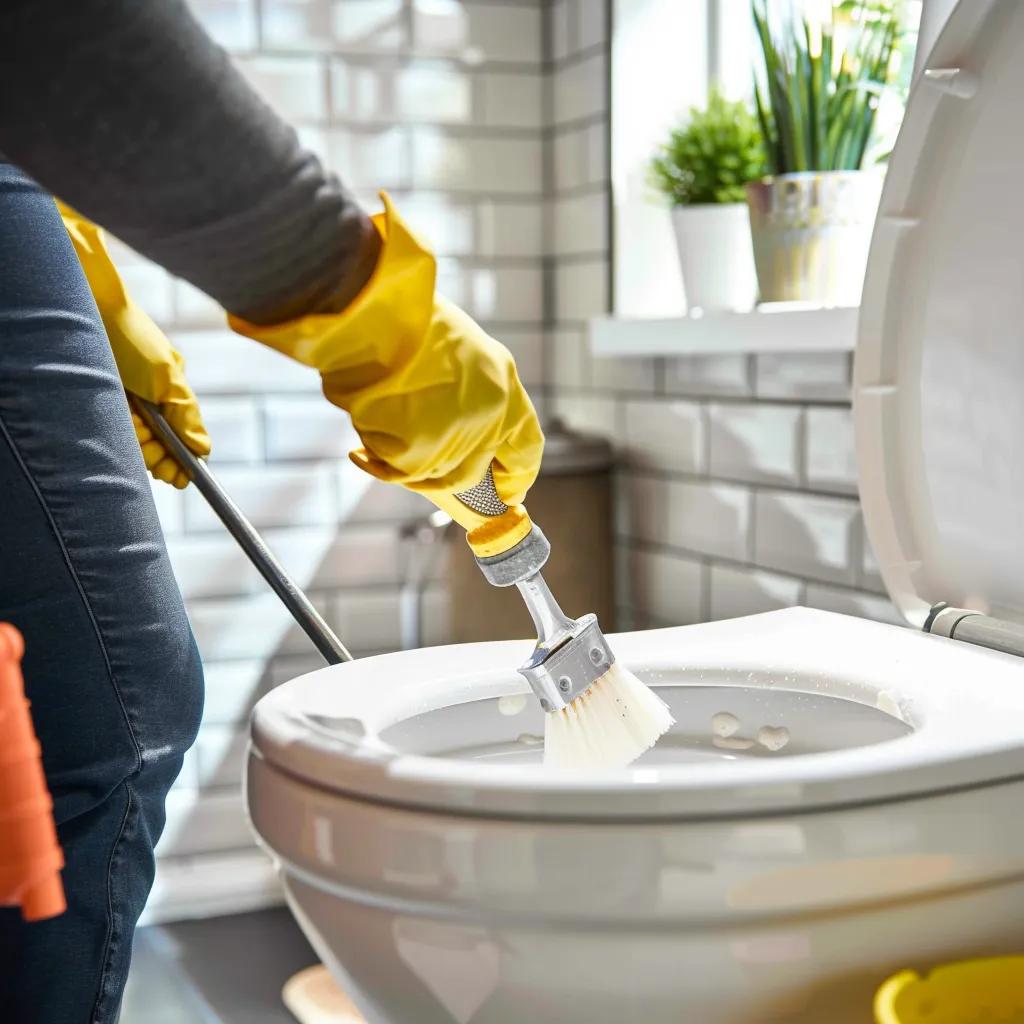
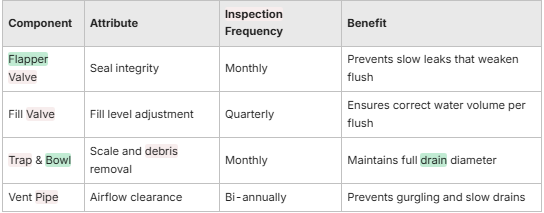
Routine checks of these elements keep your toilet operating at peak performance and prepare you for any necessary professional services.
What Toilet Components Should Homeowners Inspect Regularly?
Homeowners should visually inspect the flapper for wear, test the fill valve’s shut-off function, and brush under the bowl rim to remove scale. Checking the trap visually by watching flush speed can reveal early signs of obstruction. Ensuring vent outlets on the roof remain clear avoids pressure imbalances that slow drainage.
How Often Should You Schedule Professional Plumbing Inspections?
Scheduling a professional inspection every 12–18 months allows certified technicians to perform video camera surveys of sewer lines, identify hidden corrosion or root intrusion, and calibrate in-tank components. Regular inspections prevent minor issues from escalating and deliver peace of mind.
What Are the Benefits of Professional Drain Cleaning and Hydro-Jetting?
Professional hydro-jetting uses high-pressure water streams to flush out mineral scale, grease and tree roots without damaging pipes. This service restores full pipe diameter, removes ingrained debris and prolongs the life of your sewer system. Combined with camera inspections, hydro-jetting prevents recurring clogs more effectively than chemical cleaners.
How Do Preventative Maintenance Plans from Mitchel Plumbing and Gas Work?
Mitchel Plumbing and Gas offers tiered maintenance plans that include scheduled inspections, priority emergency response, discounted hydro-jetting services, and seasonal descaling treatments. Members receive detailed condition reports and customised action plans, ensuring proactive care and minimising unplanned repairs.
When Should You Call a Professional Plumber for Toilet Blockages?
While many minor clogs can be resolved with DIY methods, persistent or complex blockages signal deeper issues that require professional expertise. Recognising these signs early prevents water damage and costly pipe replacements.
What Are the Signs of Persistent or Complex Toilet Clogs?
Watch for:
- Repeated slow drains despite plunging
- Multiple fixtures backing up simultaneously
- Gurgling sounds in sinks or showers when flushing
- Unpleasant sewer odors near drains
How Do Sewer Line Problems and Backflow Require Expert Help?
Sewer line blockages due to collapsed pipes or root intrusion can cause waste backflow into fixtures. Professional plumbers use inspection cameras to pinpoint the obstruction and specialised cutters or hydro-jetters to restore flow safely. Attempting to address mainline issues without proper equipment risks pipe damage and sanitation hazards.
What Professional Solutions Does Mitchel Plumbing and Gas Offer?
Mitchel Plumbing and Gas provides:
- Video pipe inspection to locate hidden blockages
- Mechanical root cutting and targeted hydro-jetting
- Spot pipe repair using trenchless lining methods
- Emergency blockage removal with augers and high-pressure nozzles
Our advanced diagnostic tools and rapid-response teams resolve blockages with minimal disruption.
How Can Case Studies Demonstrate Our Expertise in Blockage Prevention?
A recent suburban case involved repeated toilet backups caused by invasive tree roots. Our team conducted a camera survey, performed hydro-jetting at 3,000 psi, and installed a root barrier, preventing further intrusion. The homeowner enjoyed uninterrupted drainage and avoided a costly line replacement.
Which Toilet Upgrades Can Help Prevent Future Blockages?
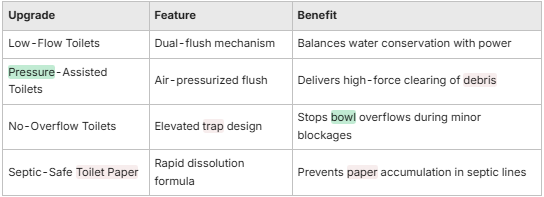
These investments modernise your bathroom while delivering long-term clog prevention and water efficiency.
How Do Modern Low-Flow and Pressure-Assisted Toilets Reduce Clogs?
Low-flow toilets use optimised trapway geometry and dual-flush options to deliver focused, high-velocity flushes that clear waste with less water. Pressure-assisted models build air pressure in the tank, releasing a powerful jet that scours the bowl and trap, reducing reliance on homeowner technique.
What Are No-Overflow Toilets and Their Role in Prevention?
No-overflow toilets feature an elevated trapway and internal overflow channel that redirects excess water back into the bowl rather than spilling onto the floor. This design prevents accidental overflows from minor blockages and protects bathroom floors from water damage.
Which Septic-Safe Toilet Papers Are Best for Clog Prevention?
Septic-safe papers use thin, quick-dissolving fibers that break apart on contact with water, minimising residue in the trap and septic tank. Recommended brands often display a septic-safe seal and dissolve within minutes when submerged, ensuring consistent performance across all toilet types.
What Are Safe DIY Methods to Unclog a Toilet Without Causing Damage?
Safe DIY Methods for Unclogging Toilets
Using a plunger correctly is a safe and effective method for clearing minor toilet blockages. The plunger should create a tight seal over the drain hole, and the user should apply steady force to dislodge debris. Additionally, a mixture of baking soda and vinegar can help loosen organic buildup.
How to Use a Plunger Correctly to Clear Minor Blockages?
Place a flange plunger over the drain hole to form a tight seal, then press and pull with steady force ten to twelve times. Maintain the seal on both the downward and upward strokes to dislodge debris in the trap. After loosening, flush with cold water to confirm full clearance.
Can Baking Soda and Vinegar Help Prevent or Remove Clogs?
Yes, a mixture of one cup of baking soda followed by one cup of vinegar creates a foaming reaction that loosens organic buildup. Let it sit for 15–20 minutes, then flush with hot water. This natural remedy maintains clear pipes and reduces mild scale accumulation without harsh chemicals.
Why Should You Avoid Chemical Drain Cleaners?
Harsh chemical cleaners contain strong acids or alkalis that can erode pipe surfaces, weaken seals and damage septic bacteria essential for waste breakdown. Repeated use accelerates pipe corrosion and increases the risk of leaks, making them an unsafe choice for long-term prevention.
What Questions Do Homeowners Commonly Ask About Toilet Clog Prevention?
Homeowners often seek straightforward answers to keep their toilets functioning reliably. Below are concise responses to frequent blocked toilet prevention queries.
What Causes a Toilet to Clog Easily?
A toilet clogs easily when excess toilet paper or non-flushable items accumulate in the trap, or when mineral scale narrows the drain path. Low-flow models with insufficient flush volume can also struggle to clear waste efficiently.
How Do I Stop My Toilet from Constantly Clogging?
Adopt consistent flushing habits and use measured paper amounts, avoid flushing foreign objects, and perform routine scale removal. If clogs recur, schedule a professional inspection to check for hidden sewer line issues or vent obstructions.
What Is the Best Thing to Put Down a Toilet to Prevent Clogs?
Using septic-safe toilet paper with rapid dissolution properties prevents paper mats in the trap. Adding an enzyme-based cleaner monthly helps break down organic residue in pipes and the septic system.
How Often Should I Replace Toilet Components to Avoid Blockages?
Replace the flapper and fill valve every 2–3 years, or at the first sign of leaks or weakened flush power. Descale the bowl and trap quarterly to prevent mineral buildup and sustain consistent flush capacity.
Preventing a blocked toilet hinges on understanding clog causes, establishing smart daily habits and investing in routine maintenance. Mitchel Plumbing and Gas’s tailored services from hydro-jetting to preventative plans that will ensure your plumbing remains clear and reliable. By combining homeowner diligence with professional expertise, you can achieve hassle-free performance, conserve water and avoid costly repairs down the line. Ready to safeguard your toilet system? Reach out for a custom maintenance plan or emergency assistance today.
Recent Post

Backflow prevention devices
Today we will be discussing the various types of backflow prevention devices on the market, as well as their relative merits and drawbacks. We will

Solar Hot Water Systems vs Gas Hot Water Systems
When Brisbane homeowners need to install a new hot water system, we at Mitchell Plumbing & Gas know that choosing between solar and gas options can be tricky. Solar hot water systems use the sun's energy to heat your water, while gas hot water systems burn natural gas or LPG to warm up your home's water supply.

6 Best Heat Pump Hot Water Systems
Heat pump hot water systems extract heat from surrounding air to efficiently warm water, using up to 75% less electricity than traditional systems. Leading Australian options include Reclaim, Sanden, Rheem, Rinnai, Dux, and Evoheat, each offering unique advantages for different household needs. These systems provide lower operational costs, reduced emissions, and eligibility for government rebates. With COPs of 3.0-5.0, they significantly outperform conventional electric and gas systems. When selecting, consider household size, climate conditions, available space, and noise levels to find the perfect match for your Brisbane home.






.svg)